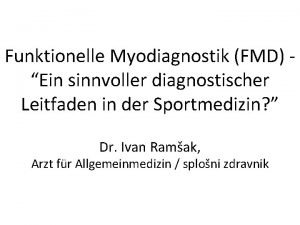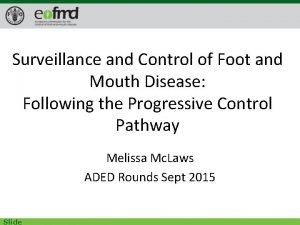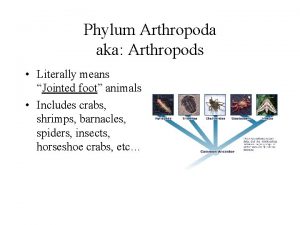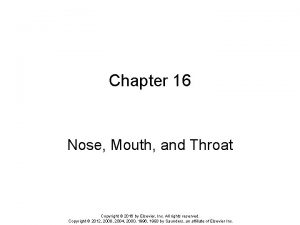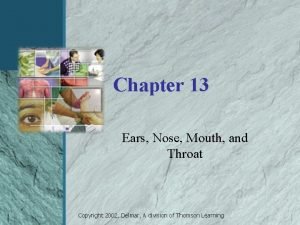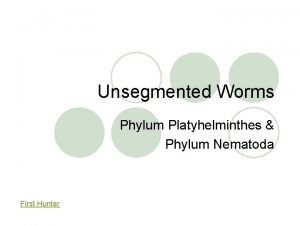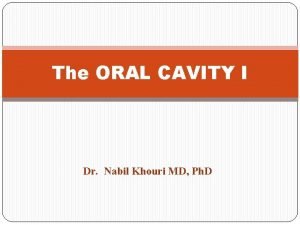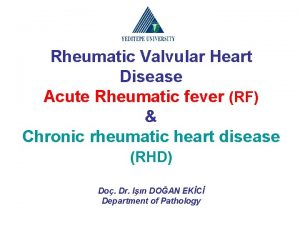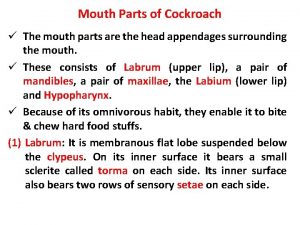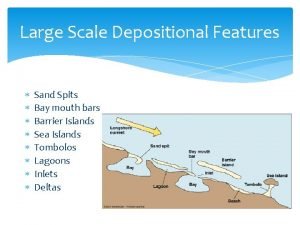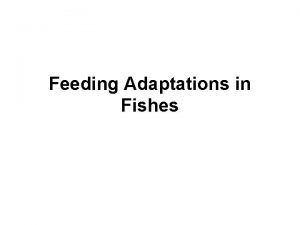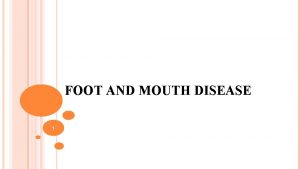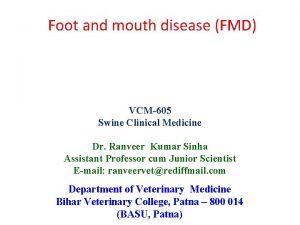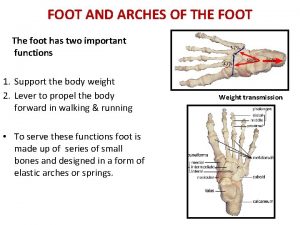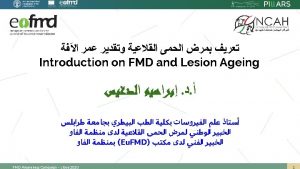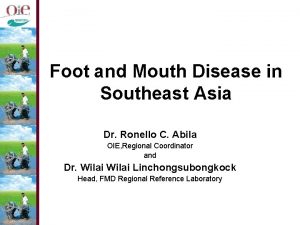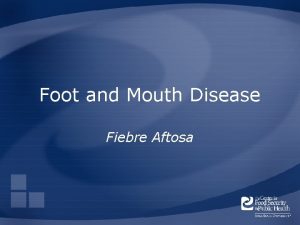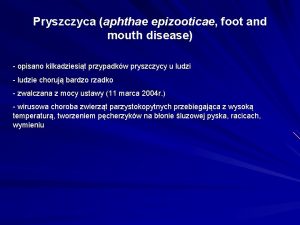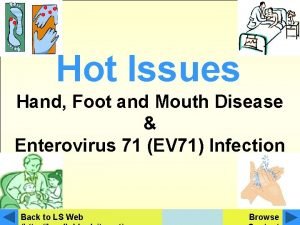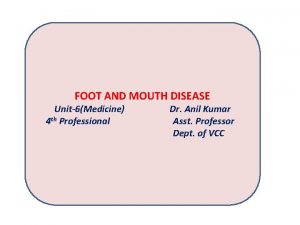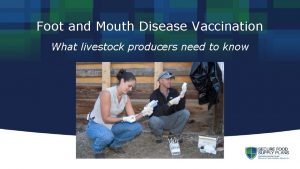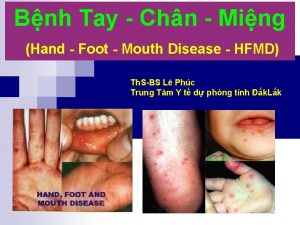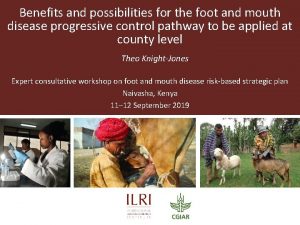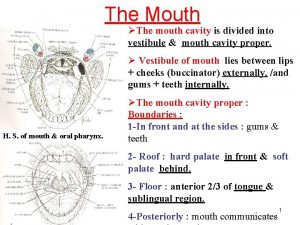FOOT AND MOUTH DISEASE FMD Clovenhoofed animals i



































- Slides: 35

FOOT AND MOUTH DISEASE (FMD)

Cloven-hoofed animals, i. e. cattle, sheep, goats, pigs, deer, elephants, and many other wild ruminants such as buffalo, impala and kudu in Africa and Humans. Zoonotic disease ! It is a characteristic viral disease with cyclic, acute, febrile vesicles and erosions. Degenerative Disorders in the Heart of Young Animals. Morbidity, mortality Economically important Notifable Disease

Etiology Picornaviridae RNA, Non-enveloped Aphtovirus The smallest Virus Resistant to Ether and Chloroform Antigenically ; 146 S Virion (serotype specific immunization inactive vaccines) 75 S Empty Capsid 12 S Kapsomer (antigenic and allergic, no immunity) 37 S Nücleic acid 7 Serotype ; A, O, C, Sat 1, 2, 3 , Asia 1 also subtypes Over 60 subtypes Antigenic variation seems to be greatest for Serotype A. In Turkey, A, O, C and Asia 1

Virus cultivation; 1 - Tissue Culture ; BHK, Cattle, pig, Chicken Fibroblast 2 - Lab animals ; mice ( 3 -5 days ) , Rattus (back foot skin) Guinea pigs which develop vesicles are the experimental host for vaccine studies and antiserum production. 3 - ECE (Embrionated chicken eggs) http: //www. fao. org/ag/againfo/programmes/en/empres/gemp/avis/A 010 -fmd/tools/0 -imag-cytopathic-effect. html

Virus could continue the long-term viability of the environment. Acid sensitive, FMDV is rapidly inactivated in the muscles, which become acid during the "setting" of meat, but survives well in the lymph nodes and bone marrow of chilled or frozen carcases. The Most Important role in Contagion Cattle movements. Direct Contamination; 1 - Contact ; a- The barn, pasture, animal markets. b- Urine, feces, saliva, Vesicle 2 - Plecental Inf ; pregnant sheep 3 - Insemination Inf ; via Semen 4 - Milking Inf; via mother’s milk 5 - Vaccine Inf ; via vaccination

Indirect transmission; 1 -Food Ingredients; Milk, Cheese 2 -Cropped Animal Products; Meat, Fat, Organ 3 -Slaughterhouse Products; Horn, Nail, Blood 4 -Animal Products; Leather, Wool, Bone marrow 5 -Dirty Waters; Slaughterhouse Waters 6 -Streams; Kadars in the rivers 7 -Dirty Places 8 -Dresses and Materials Assistant Staff; Barn, A. Market Other Animals; rodents Serpent Tortoise Wild Animals

WHY IS FOOT AND MOUTH DISEASE SO MUCH CONTAGIOUS There are many types and subtypes of the agent, the cross-immunity between them is none or low Since the mutation rate of the virus is very high and therefore constantly developing new viruses with the continuous development of new viruses The virus is spread all over the body with its secretions and excretions very long time Virus spreading starts 4 days before lesions are seen and can continue until 15 days after the lesions are seen. Although the morbidity of the disease is very high, the mortality rate is low The host of the disease is quite extensive, the virus can continue its long-term viability of the environment The amount of virus required to initiate infection is very low

Pathogenesis and Clinical Signs Incubation Period; In cattle; 2 -7 days In the sheep; 1 -6 days The entrance of the disease is the respiratory system. The first symptom is high fever, It disappears with vesicle formation. It is a cyclic disease and spreads to the whole body via viremia and forms vesicles in organs. The first virus is pharynx, then spread to other tissues by viremia. Where the virus enters the body, Primer vesicles occur then Seconder vesicles after Viraemia.

Generalization Viremia Primer vesicles Virus enterance Accumulation of the virus specific organs Seconder vesicles

vesicles appear inside the mouth and around the muzzle, in the interdigital cleft and around the coronary band on the teats. These lesions cause excessive salivation, smacking of the lips, and anorexia, lameness and then secondary mastitis. Internally, lesions may be found in the oesophagus and fore-stomachs. FMDV is a thus very painful disease with a rapid loss of condition and milk yield but most adult animals survive. Ageing of lesions in cattle Days of clinical disease Day 1 Blanching of epithelium followed by formation of fluid-filled vesicle. Day 2 Freshly ruptured vesicles characterised by raw, bright-red exposed dermis, a clear edge to the lesion and no deposition of fibrin. Day 3 Lesions start to lose their sharp demarcation and bright-red colour. Deposition of fibrin starts to occur. Day 4 Considerable fibrin deposition has occurred and regrowth of epithelium is evident at the periphery of the lesion. Day 7 Extensive scar tissue formation and healing has occurred. Some fibrin deposition is usually still present. http: //www. fao. org/ag/againfo/programmes/en/empres/gemp/avis/A 010 -fmd/mod 0/0213 -ageing-lesions. html

In the young, gray-yellow, gray-white stains form the Tiger's View in the Heart. (pathognomonic) Death from myocarditis occurs in calves, lambs and piglets without maternal antibody to FMDV. Pig: Focal myocarditis, 'tiger striping' on the heart of a 4 -week old piglet which died due to FMD. http: //www. fao. org/ag/againfo/programmes/en/empres/gemp/avis/A 010 -fmd/tools/0 -imag-pig-focal-myocarditis. html

In sheep, goat and pigs disease is less obvious but vesicles are common around the nose, mouth and coronary band. Exungulation is common in pigs. In goats, mouth lesions are more common than cattle. Generally, the disease is less severe than cattle. Sheep: Sheep mouth lesion; lesion on the lower gums and dental pad of a sheep on the first day of clinical disease. Sheep: Freshly ruptured vesicle along the coronary band of the interdigital space of a sheep two days after the onset of overt clinical disease. http: //www. fao. org/ag/againfo/programmes/en/empres/gemp/avis/A 010 -fmd/tools/0 -imag-sheep-lesion-foot. html Pig: Vesicles and blanching of the coronary band in pigs on the first day of clinical disease.

Immunology Active and Passive Immunity occur. Immunity is type-specific. Due to the structure of Virus Complex, after infection; neutralizing precipitating Complement Fix. Antibodies occur. Recovered animals produce antibody and resist reinfection by the same subtype of virus for up to one year or more. When immunity has waned, re-exposure to the original subtype can result in a local infection which results in virus excretion without clinical symptoms. If re-exposure is to a second serotype or subtype there is little or no resistance to clinical disease.

Diagnosis Clinical Symptoms and Epizootologic condition helps diagnose. The best materials for diagnosis are vesicle fluid and 1 square inch of epithelium preferably from unruptured lesions. Scrapings from ruptured vesicles are also useful. Sedation with Rompun may be necessary. Virus survives best at p. H of 7. 2 -7. 8 and so 50% glycerol with 50% PBS p. H 7. 6 is the traditional transport medium. Steer with FMD tongue lesions. © UK DEFRA. https: //scienceblog. com/wp-content/uploads/2012/07/foot-and-mouth-disease. jpg http: //www. thecattlesite. com/images/plate_12. jpg

Diagnosis; A- Virus Isolation; fresh vesicles and saliva are inoculated to cell culture vesicle fluid is inoculated into kidney cell cultures and suckling mice which detects less virus. B- Serological Diagnosis; Complement Fixation T. ELISA, ARE SEROTYPE SPECIFIC, IE ALL 7 SEROTYPES MUST BE TESTED FOR with 8 different antisera. Charecterization of types ELISA and CFT AGPT PCR

Differential Diagnosis 1 -Complex of Vesicular Diseases; Foot & Mouth Disease Clinical Signs by Species Vesicular Stomatitis Vesicular Exanthema of Swine All vesicular diseases produce a fever with vesicles that progress to erosions in the mouth, nares, muzzle, teats, and feet Cattle Oral & hoof lesions, salivation, drooling, lameness, abortions, death in young animals, "panters"; Disease Indicators Vesicles in oral cavity, mammary glands, coronary bands, interdigital space Pigs Severe hoof lesions, hoof sloughing, snout vesicles, less severe oral lesions: Amplifying Hosts Same as cattle Sheep & Goats Mild signs if any; Maintenance Hosts Not affected Horses, Donkeys, Mules Swine Vesicular Disease Not affected Severe signs in animals housed on concrete; lameness, salivation, neurological signs, younger more severe Deeper lesions with granulation tissue formation on the feet Rarely show signs Not affected Most severe with oral and coronary band vesicles, drooling, rub mouths on objects, lameness Not affected Fiebre Aftosa, Center for Food Security and Public Health at Iowa State University

2 - Complex of Mucosal Diseases; a- Mucosal Disease; no vesicle b- Rinderpest; no vesicle. High fever, Bloody diarrhea, sparkling saliva c- Coriza G. Bovum; Transmission is local. Conjuktivitis, CNS d-IBR-IPV; No vesicle 3 - Pox Disease Complex; a- Stomatitis papullosa; No vesicle. b- Pseudocowpox; Pustules are typical. c- Vaccinia; pox pustules. d- Mamillitis; nipple vesicles

Preventation and Control Slaughtering and Destruction Quarantine and Vaccination Systemic Vaccination The most effective method is quarantine, disinfection and vaccination. In endemic areas annual vaccination using the local subtypes is essential to prevent transmission. In such endemic areas disease cannot be prevented by slaughter because of the large number of migrant carrier stock, particularly sheep, eg in S. America, and recovered animals eg in India/Jordan. Thrace is FMD FREE ZONE! Vaccination with quarantine measures for the control of FMD in Turkey has been implemented since 1962. WHEN DIAGNOSIS OF FMD PRECAUTIONS TO BE SUBMITTED: Quarantine about 10 km of the outbreak

VACCINES 1 -Waltman - Köbe Vaccine; Virus is given to the cattle tongue as a cuticle, and the resulting lesions are collected and used as vaccine material. 2 -Frenkel Vaccine; Healthy Cutting cattle slices are collected and thin layers of epithelial cells are removed. Here the vaccine is prepared by producing virus. 3 -Tissue Culture Vaccine; Monolayer or Suspension Prepared in BHK-21 Cell Cultures. Serotype Specific INACTIVE VACCINES Monitor disease outbreaks Stock active serotypes and strains Essential to isolate virus and identify the serotype to select correct vaccine Vaccine could be prepared as Monovalent, Bivalent and Trivalent. Vaccine is applied to dewlap, twice or triple a year. The duration of the immunization that occurs after inoculation with inactivated vaccines is about 6 months. It depends on the adjuvant type, the potency of the vaccine and the animal species)

FMD in Humans People are less sensitive to infection. The disease is by direct contact with animals and laboratory infections. Indirectly, the transmission of infection with milk. The incubation period is 2 -6 days. Fever, Fatigue, Diarrhea, Pain in the head, arms and legs, vesicle and erosions in the mouth region. The prognosis is good. Healing in 5 -10 days. CDC Public Health Image Library Center for Food Security and Public Health, Iowa State University, 2011

Major losses caused by foot-and-mouth disease - Losses in milk and meat yields - Abortions in pregnant animals - Very high mortality, especially in young animals - Economic losses due to restrictions on external trade.

Challenging factors There is no cross-immunity between the 7 subtypes of the virus. Immune alteration between multiple antigenic variants. Vaccination should be done at least twice a year. Immunization after vaccination is short term. Viruses that exotic for Turkey exist in eastern and southeastern neighbors.

Disinfections Aim To prevent the spread of infection by providing effective and effective decontamination of businesses, people, equipment and vehicles, to prevent recurrence of the infection following the introduction of the animal again. Disinfectants known for efficacy against FMD virus Sodium hypochlorite 3% Acetic acid (Vinegar) 4 -5% For disinfection of buildings not suitable Potassium peroxymonosulphate and Sodium Chloride 1 -2% use accordance with the operating instructions Sodium Carbonate 4% Light burner. Sodium Hydroxide 2% It is very burning. Use protective clothing, gloves and goggles. it is quite burning for general use.

ENTEROVIRUS INFECTIONS OF CATTLE Symptoms Respiratoric System inf Enteritis Virus could be isolated from both sick and clinically healthy animals.

ETHIOLOGY Picornaviridae Enterovirus RNA, Non-enveloped, Resistant to Ether and Chloroform Hemagglutination Resistant to acid and alkali– gastrointestinal system Tissue culture (Lamb-Human-Monkey-Rabbit Kidney) ECE , chick Fibroblast , Guineapigs 10 serotype (E-6 serotype, F-4 serotype) Two serotypes were detected by Neutralization and Complement Fixation Test.

BEV-1 Domestic Cattle, Water Buffer, Sheep, Cowder, Dog, African Buffalo, and Human BEV-2 is only seen in Domestic Cattle. Entero E common in domestic cattle Entero F less Virus isolation, Phrangeal Swap ve feces Infection is spread by infected animal products.

Clinical Symptoms Subclinical infections in cattle and calves Mostly, Diarrhea, Respiratory Symptoms rarely cause vaginitis and balanopostitis. Also virus may cause infertility, abortion and stillbirths.

Pathogenesis Fecal-oral route Virus Oral enters the body and reaches the respiratory tract. Once it is placed in the digestive tract, it initiates infection. Subclinical inf

Diagnosis The virus can be isolated from healthy and infected cattle Gaita, Lung, Rhinitis, Testes, semen, Genital Organs and fetus. Serologically, Neutralization and Complement Fixation test are used. Immunology Ig. G antibodies

Bovine Rhinovirus infections Virus causes mild acute respiratory tract infections in the calves and adult cattle. Pneumonia Enzootic Bronchopneumonia is associated with PI-3 and Crowding Disease. (important in mix infections)

Ethiology Picornaviridae ----- Rhinovirus RNA, non-enveloped Resistant to Ether and Chloroform 3 serotype The virus could only be isoloted in the Bovine kidney cell culture at 33 C in a slightly acidic medium Virus spread through respiratory tract mucosa and nasal discharge. (till 22 days)

Clinical Signs and Symptoms Transmission is direct and indirect routes. The incubation period is 2 -4 days. in every seasons Fever, nasal discharge, loss of appetite, cough anorexia and dyspnea are seen. Interstitial Pneumonia is seen in experimental infections.

Diagnosis Clinically, diagnosis is not possible. The neutralization test of the double serum sample could be performed. PCR Direct isolation of the virus is very difficult. Virus could be isolated by the nasal discharge taken during the acute phase of the disease in bovine kidney cell culture at 33 ° C.

Immunology In cattle, Neutralizing Antibodies occur after rhinovirus infection. Neutralizing Antibodies are transplanted into newborns with colostrum. Hygiene measures, disinfection and fight against secondary infections.

 Tfl anatomie
Tfl anatomie Fmd
Fmd Fmd
Fmd Communicable disease and non communicable disease
Communicable disease and non communicable disease You put your right foot in you put your right foot out
You put your right foot in you put your right foot out A 75 foot building casts an 82 foot shadow
A 75 foot building casts an 82 foot shadow Are bears producers or consumers
Are bears producers or consumers Detritus food chain
Detritus food chain Carnivore
Carnivore Jointed foot
Jointed foot Kyle douglass
Kyle douglass Myxini characteristics
Myxini characteristics Copyright
Copyright Nose assessment normal findings
Nose assessment normal findings Hi my name is junie b jones
Hi my name is junie b jones Formation of waterfalls
Formation of waterfalls Small flat unsegmented worms
Small flat unsegmented worms Mylohyoid
Mylohyoid Git layers
Git layers Digestion in mouth
Digestion in mouth Mouth esophagus stomach intestines
Mouth esophagus stomach intestines Fish mouth or buttonhole stenosis
Fish mouth or buttonhole stenosis John kirby mouth
John kirby mouth Serongagandi ensemble
Serongagandi ensemble Othello act 2
Othello act 2 Mouth preparation adalah
Mouth preparation adalah Maxillae insects
Maxillae insects Mouth parts of cockroach
Mouth parts of cockroach A new way to measure word-of-mouth marketing
A new way to measure word-of-mouth marketing Bell mouth gate
Bell mouth gate Barrier islands
Barrier islands Lamp mouth leviathan
Lamp mouth leviathan Mouth parts
Mouth parts Frog mouth dissection
Frog mouth dissection Ribbon fish teeth
Ribbon fish teeth Kevin james picking out a card
Kevin james picking out a card
